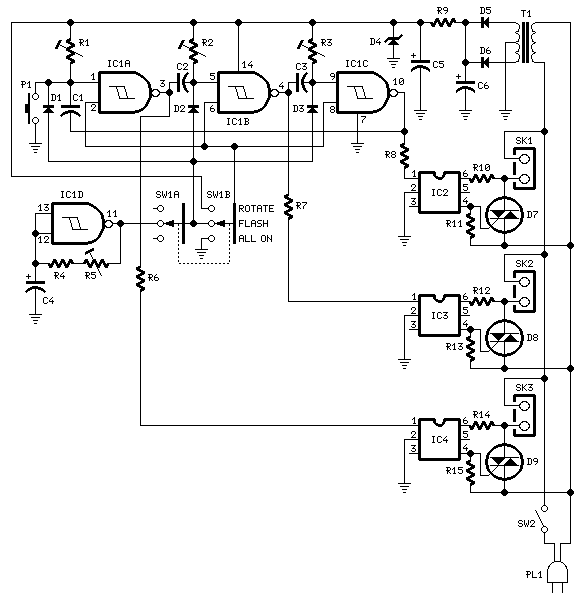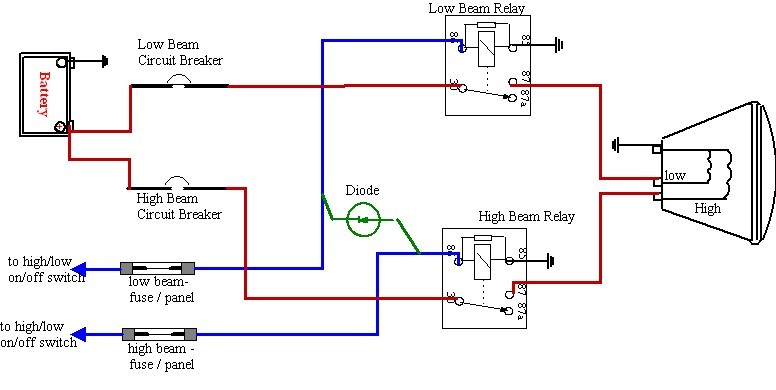
light gate with counter

The circuit detailed here counts the number of times an infrared beam is interrupted. It can be utilized to track the number of individuals entering a room or to monitor how frequently an object, such as a ball, passes through an opening, which is particularly useful in games like shuffleboard. The core of the circuit features a light gate. Diode D1 is an infrared (IR) diode that continuously illuminates IR transistor T1. The light incident on T1 causes it to conduct to a certain degree, resulting in a collector voltage that is low enough to prevent the subsequent transistor (T2) from conducting. This voltage can be adjusted within specific limits using potentiometer P1. When an object obstructs the light between D1 and T1, the light that reaches T1 is partially or completely blocked, leading to reduced current conduction in the IR transistor. Consequently, the voltage at its collector rises, generating a brief increase in the voltage at the base of T2. This action activates T2, producing a negative edge at IC1. This negative edge triggers a monostable multivibrator, which maintains the output signal on pin 3 high for a predetermined duration (one second in this instance). During this interval, two actions occur: first, a buzzer is activated by the output of IC1, emitting a tone for approximately one second. Following the buzzer's sound, a negative edge is sent to the clock input of IC2, incrementing the counter within IC2 by one. IC2 includes an internal binary-to-BCD decoder, allowing its outputs to be buffered by IC3 and T3 to display the counter's state on a 7-segment display. Switch S1 can reset the counter to zero. If a one-second interval is not suitable, the timing can be adjusted by modifying the values of R3 or C1; increasing R3 will lengthen the interval, while decreasing it will shorten it, with similar effects applicable to C1. During construction, it is important to ensure that T1 is adequately illuminated by D1 while minimizing exposure to ambient light. This can be achieved by placing T1 in a narrow tube precisely aligned with D1, as a longer tube will reduce the amount of ambient light reaching T1. The circuit's sensitivity can be fine-tuned using P1.
The circuit operates by utilizing infrared light to create a counting mechanism based on interruptions of the beam. The IR diode (D1) continuously emits infrared light, which is directed toward the IR transistor (T1). When the path of this light is unobstructed, T1 remains in a conductive state, keeping the voltage at its collector low enough to prevent T2 from turning on.
When an object interrupts the infrared beam, T1 receives less light, reducing its conduction and causing the collector voltage to rise. This change triggers T2, which sends a negative pulse to IC1. The monostable multivibrator within IC1 generates a high output for one second, allowing the buzzer to sound and providing a visual indication on the 7-segment display via IC2 and its decoder.
The output from IC1 not only provides an auditory alert but also serves as a clock pulse for IC2, which counts each interruption. The design incorporates a reset switch (S1) for convenience, allowing the user to clear the count when necessary.
For applications requiring different timing intervals, the circuit has been designed to allow easy adjustments to the timing components (R3 and C1), providing flexibility based on user requirements. The construction of the circuit should focus on optimizing the light path and minimizing interference from ambient light to enhance the reliability and accuracy of the counting mechanism. The inclusion of a potentiometer (P1) adds an additional layer of customization, enabling the user to adjust sensitivity based on the specific environment in which the circuit is deployed.The circuit described here counts the number of times that an infrared beam is interrupted. It could be used to count the number of people entering a room, for instance, or how often a ball or another object passes through an opening (handy for playing shuffleboard). The heart of the circuit consists of you guessed it a light gate! Diode D1 is an IR diode that normally illuminates IR transistor T1. The light falling on T1 causes it to conduct to a certain extent. The resulting voltage on the collector of T1 should be just low enough to prevent the following transistor (T2) from conducting. This voltage can be adjusted within certain limits using P1. As soon as an object comes between D1 and T1, the light shining on T1 will be partially or fully blocked, causing the IR transistor to conduct less current.
As a result, the voltage on its collector will increase, producing a brief rise in the voltage on the base of T2. This will cause T2 to conduct and generate a negative edge at IC1. This negative edge will trigger the monostable multivibrator, which will then hold the output signal on pin 3 high` for a certain length of time (in this case, one second).
Atthis point, two things will occur. First, a buzzer will be energised by the output of IC1 and produce a tone for approximately one second. When the buzzer stops, a negative edge will be applied to the clock input of IC2, causing the counter in IC2 to be incremented by 1.
IC2 is conveniently equipped with an internal binary-to-BCD decoder, so its outputs only have to be buffered by IC3 and T3 to allow the state of the counter to be shown on the 7-segment display. Switch S1 can be used to reset the counter to zero. If a one-second interval does not suit your wishes, you can modify the values of R3 or C1 to adjust the time.
Increasing the value of R3 lengthens the interval, and decreasing it naturally shortens the interval. The same is true of C1. When building the circuit, make sure that T1 is well illuminated by the light from D1, while at the same time ensuring that T1 sees` as little ambient light as possible.
This can best be done by fitting T1 in a small tube that is precisely aimed toward D1. The longer the tube, the less ambient light will reach T1. The sensitivity of the circuit can be adjusted using P1. 🔗 External reference
The circuit operates by utilizing infrared light to create a counting mechanism based on interruptions of the beam. The IR diode (D1) continuously emits infrared light, which is directed toward the IR transistor (T1). When the path of this light is unobstructed, T1 remains in a conductive state, keeping the voltage at its collector low enough to prevent T2 from turning on.
When an object interrupts the infrared beam, T1 receives less light, reducing its conduction and causing the collector voltage to rise. This change triggers T2, which sends a negative pulse to IC1. The monostable multivibrator within IC1 generates a high output for one second, allowing the buzzer to sound and providing a visual indication on the 7-segment display via IC2 and its decoder.
The output from IC1 not only provides an auditory alert but also serves as a clock pulse for IC2, which counts each interruption. The design incorporates a reset switch (S1) for convenience, allowing the user to clear the count when necessary.
For applications requiring different timing intervals, the circuit has been designed to allow easy adjustments to the timing components (R3 and C1), providing flexibility based on user requirements. The construction of the circuit should focus on optimizing the light path and minimizing interference from ambient light to enhance the reliability and accuracy of the counting mechanism. The inclusion of a potentiometer (P1) adds an additional layer of customization, enabling the user to adjust sensitivity based on the specific environment in which the circuit is deployed.The circuit described here counts the number of times that an infrared beam is interrupted. It could be used to count the number of people entering a room, for instance, or how often a ball or another object passes through an opening (handy for playing shuffleboard). The heart of the circuit consists of you guessed it a light gate! Diode D1 is an IR diode that normally illuminates IR transistor T1. The light falling on T1 causes it to conduct to a certain extent. The resulting voltage on the collector of T1 should be just low enough to prevent the following transistor (T2) from conducting. This voltage can be adjusted within certain limits using P1. As soon as an object comes between D1 and T1, the light shining on T1 will be partially or fully blocked, causing the IR transistor to conduct less current.
As a result, the voltage on its collector will increase, producing a brief rise in the voltage on the base of T2. This will cause T2 to conduct and generate a negative edge at IC1. This negative edge will trigger the monostable multivibrator, which will then hold the output signal on pin 3 high` for a certain length of time (in this case, one second).
Atthis point, two things will occur. First, a buzzer will be energised by the output of IC1 and produce a tone for approximately one second. When the buzzer stops, a negative edge will be applied to the clock input of IC2, causing the counter in IC2 to be incremented by 1.
IC2 is conveniently equipped with an internal binary-to-BCD decoder, so its outputs only have to be buffered by IC3 and T3 to allow the state of the counter to be shown on the 7-segment display. Switch S1 can be used to reset the counter to zero. If a one-second interval does not suit your wishes, you can modify the values of R3 or C1 to adjust the time.
Increasing the value of R3 lengthens the interval, and decreasing it naturally shortens the interval. The same is true of C1. When building the circuit, make sure that T1 is well illuminated by the light from D1, while at the same time ensuring that T1 sees` as little ambient light as possible.
This can best be done by fitting T1 in a small tube that is precisely aimed toward D1. The longer the tube, the less ambient light will reach T1. The sensitivity of the circuit can be adjusted using P1. 🔗 External reference





